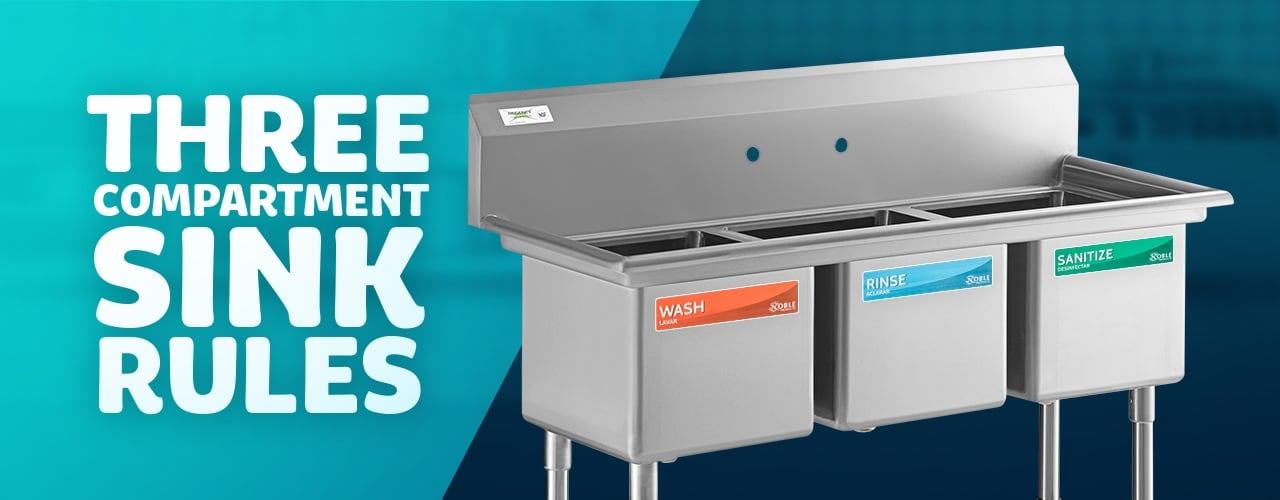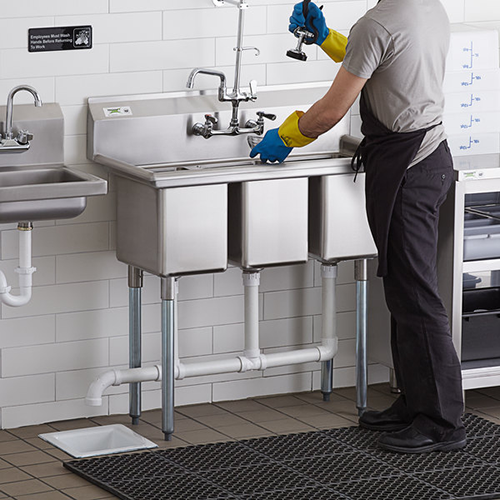
Clean and sanitary tableware is as fundamental to restaurants as a menu. When used properly, three compartment sinks help restaurants stay up to health code standards. However, you must train your staff to follow all the steps in the three sink method. Noncompliance with three compartment sink rules can lead to food-borne illnesses, hefty fines, and, at worst, restaurant closures. To help prevent these damaging consequences, we’ve created a guide explaining how to use your three compartment sink correctly.
Shop All Three Compartment Sinks- 3 Sink Method
- 3 Compartment Sink Order
- Three Compartment Sink Steps
- Water Temperature in a Three Compartment Sink
- What Sanitizer Is Commonly Used in the Three Sink System?
- 3 Compartment Sink Sanitizer Temperature
- When Is It Essential to Clean and Sanitize a Utensil?
- Review Your 3 Compartment Sink Knowledge
How to Use a Three Compartment Sink
Our video breaks down the simple steps of using a three compartment sink in a commercial kitchen.
3 Sink Method

The three sink method is the manual procedure for cleaning and sanitizing dishes in commercial settings. Rather than providing additional workspace to perform the same function, the three compartments allow kitchen staff to wash, rinse, and sanitize dishes. Each step has its own set of rules and requirements.
The three sink method predates commercial dishwashers and is a reliable, FDA-approved way to clean commercial dishware, cookware, and kitchen utensils. Since not all utensils and cookware items are dishwasher safe, and many large pots won't fit in dishwashers, three compartment sinks remain essential to foodservice establishments.
Important: Never use your three compartment sink for anything other than cleaning, rinsing, and sanitizing dishes. Do not permit hand washing or the dumping of mop water in your three compartment sink.3 Compartment Sink Order
The FDA requires commercial foodservice establishments to both clean and sanitize their dishes in their manual washing process. Three compartment sinks have a logical order to help you properly clean and sanitize dishes. While those who misunderstand the terms use them interchangeably, cleaning and sanitizing refer to two separate functions. Cleaning is the act of removing surface debris, and sanitizing is the act of using a chemical agent or hot water to kill invisible bacteria. Label each sink to help staff remember the FDA required three compartment sink order.
- Sink 1 = Wash
- Sink 2 = Rinse
- Sink 3 = Sanitize
Three Compartment Sink Steps

While there are only three sinks, there are five essential steps you need to complete when using your three compartment sink. We’ve outlined the five steps in the manual commercial dishwashing method below so you can adhere to the FDA’s three compartment sink rules.
- Remove food: Scrape leftover food off the dishes.
- Scrub: Use the first sink to scrub the dishes in soapy, warm water (minimum temperature of 110 degrees Fahrenheit required).
- Rinse: Use the second sink to rinse the dishes in clean, warm water (minimum temperature of 110 degrees Fahrenheit).
- Soak: Use the third sink to soak the dishes in a chemical sanitizing solution. Refer to the directions provided by your chosen sanitizer to determine how long the dishes need to remain submerged. Alternately, you can use hot water at 171 degrees Fahrenheit or hotter instead of sanitizing chemicals. If you choose to sanitize in hot water, leave the dishes sitting in the scalding water for a minimum of 30 seconds.
- Dry: Always air-dry the dishes. Otherwise, you risk recontamination.
Important: Replace the water whenever it appears dirty.

Water Temperature in a Three Compartment Sink
The required water temperature in a three compartment sink depends on the sink you’re filling. The water in the first and second sink needs to be a minimum of 110 degrees Fahrenheit to meet the FDA requirements. If you plan to use water in your third sanitizing sink, the water must be 171 degrees Fahrenheit or hotter. Check with your local health guidelines to make sure you’re adhering to regional requirements.
Important: Use a thermometer to check the water temperature.
Back to TopWhat Sanitizer Is Commonly Used in the Three Sink System?

The most commonly used sanitizer in the three sink system is chlorine bleach because it’s the cheapest option. You can purchase regular bleach, dilute it to 50 or 100ppm, and use it in your three compartment sink. Other popular sanitizer options for three compartment sinks are quat (QAC) and iodine.
Important: Protect your employees by outfitting them with dishwashing gloves.
3 Compartment Sink Sanitizer Temperature
Each of the commonly used chemical sanitizers has a unique temperature requirement. Whichever sanitizing solution you choose, you must leave the dishes submerged in the sanitizer for at least one minute. Check your local health guidelines to comply with their specific sanitizer soak time stipulations.
- Chlorine Solution = 75-120 degrees Fahrenheit
- Quaternary Solution = 75-90 degrees Fahrenheit
- Iodine Solution = 75 degrees Fahrenheit
When Is It Essential to Clean and Sanitize a Utensil?
From utensils to kitchen sheers, you must clean and sanitize every surface that interacts with food items after four hours of use. However, there are additional requirements that increase cleaning and sanitizing frequency. We break down when you need to clean and sanitize utensils and kitchen tools below.
- Every item used requires cleaning and sanitation.
- If your food prep task is interrupted, clean and sanitize your tools when you return.
- Clean and sanitize when you switch to a new food item (ex. chopping vegetables to working with raw meat).
- Every surface that interacts with food items must be cleaned and sanitized after every four hours of use.
Back to Top
3 Compartment Sink Procedure Review

Now that you’ve learned all about three compartment sink rules and the steps you need to take to comply with them, it’s time to test your knowledge. Answer the questions below to see if you’re ready to use your three compartment sink or if you need to review this resource some more.





